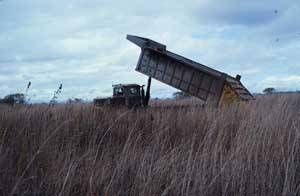|
|
 46 trial peel biodegradation DHJanzen100049.jpg high resolution
|
|
| So now the juice is gone, and the essential oils are gone, what is left? Half of the orange is peel/pulp. This means that for every one of those thousand truckloads of oranges there is a half a truckload of peel/pulp. I asked the juice company how were they planning to get rid of it. They said, well, in Florida they dry it down into pellets and sell it as cattle feed. But this is not Florida. Would the local cattle growers take it? They had asked, but they were afraid that it would give a flavor to the milk. Hmm. What about the cattle growers for beef in the dry side of Costa Rica? Give it a try. They did. The cattle would eat it, but there really was not enough value to be worth the cost to the ranchers to truck it to their cattle. Hmm. I looked at the operation, and said to the juice company, hey, would you give me 100 truckloads of peel/pulp, placed where I want it and leveled? They said sure. I was betting that out of 235,000 species of things in the ACG, there would be at least ONE that liked to eat orange peels. Here, you see the first time a truckload of orange peel/pulp has been placed happily in a national park (really, in the ACG). It is going down into a several-century old abandoned cattle pasture, bought and slated for restoration into forest, a process that is going excruciatingly slowly because the seed sources are more than 1 km distant and because the soil is almost totally exhasted of nutrients. The grasss - jaragua (Hypparhenia rufa) - is introduced from eastern Africa. | ||
back to lecture slides
or skip to: